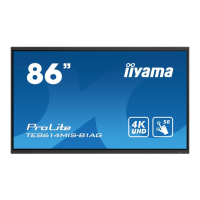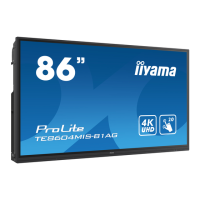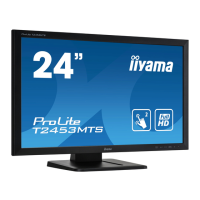
Do you have a question about the Iiyama ProLite TE8612MIS and is the answer not in the manual?
| Haze rate | 28 % |
|---|---|
| Panel life | 50000 h |
| Pixel pitch | 0.4935 x 0.4935 mm |
| Response time | 8 ms |
| Display diagonal | 86 \ |
| Surface hardness | 7H |
| Display brightness | 400 cd/m² |
| Display technology | LED |
| Number of displays | 1 |
| Native aspect ratio | 16:9 |
| Horizontal scan range | 30 - 135 kHz |
| LED backlighting type | Direct-LED |
| Touchscreen technology | Infrared |
| Display number of colors | 1.073 billion colors |
| Display diagonal (metric) | 217.4 cm |
| Active display area (W x H) | 1895 x 1066 mm |
| Number of simultaneous touchpoints | 40 |
| Orientation | Horizontal |
| Product color | Black |
| Product design | Digital signage flat panel |
| Bezel width (side) | 16.5 mm |
| Placement supported | Indoor |
| Bezel width (bottom) | 31 mm |
| Positioning accuracy | 1.5 mm |
| Panel mounting interface | 800 x 600 mm |
| Bluetooth version | 5.0 |
| Power supply type | Internal |
| Internal memory | 32 GB |
| Processor cores | 4 |
| Internal storage capacity | 4 GB |
| Operating system installed | Android 11 |
| On-board graphics card model | ARM Mali-G52 |
| DVI port | - |
| USB version | 2.0/3.2 Gen 1 (3.1 Gen 1) |
| Wi-Fi standards | 802.11a, 802.11b, 802.11g, Wi-Fi 4 (802.11n), Wi-Fi 5 (802.11ac) |
| USB connector type | USB Type-C |
| USB ports quantity | 6 |
| HDMI input ports quantity | 3 |
| Ethernet LAN (RJ-45) ports | 2 |
| RMS rated power | 32 W |
| Purpose | Commercial |
| HDCP version | 2.2 |
| Number of OSD languages | 9 |
| Operating hours (hours/days) | 16/7 |
| On Screen Display (OSD) languages | CZE, DEU, DUT, ENG, ESP, FRE, ITA, POL, RUS |
| Sustainability certificates | RoHS, WEEE |
| Cables included | AC, HDMI, USB |
| Base material | Metal |
| Storage temperature (T-T) | -20 - 60 °C |
| Operating temperature (T-T) | 0 - 40 °C |
| AC input voltage | 100 - 240 V |
| AC input frequency | 50 - 60 Hz |
| Power consumption (off) | 0.3 W |
| Power consumption (standby) | 0.5 W |
| Power consumption (typical) | 215 W |
| Package depth | 225 mm |
| Package width | 2110 mm |
| Package height | 1283 mm |
| Package weight | 75900 g |
| Display depth | 100 mm |
|---|---|
| Display width | 1957 mm |
| Display height | 1160 mm |
| Display weight | 58600 g |
Checklists for common issues and information required for reporting screen defects.
Declaration of conformity with EC/EU directives and warning about radio interference.
Critical warnings for safe operation, installation, and handling to prevent fire or electric shock.
Guidelines on installation location, ventilation, handling, and ergonomic recommendations for user comfort.
Highlights key features such as resolution, contrast, connectivity, and mounting standards.
Identification and function of front-mounted buttons, indicators, and input/output ports.
Identification and function of rear-mounted ports, speakers, and switches.
Detailed explanation of remote control buttons and their corresponding operations.
Turning the monitor on/off, standby mode, and accessing the adjustment menu.
How to navigate menus using the remote control and perform basic operations like volume and input switching.
Step-by-step guide for connecting the monitor to a computer and peripherals, including USB-C features.
Configuration of signal timing and compatibility of multi-touch functions with various operating systems.
Procedure for adjusting picture settings, navigating menus, and making adjustments via remote or touch.
Accessing common settings and adjusting input, volume, and backlight.
Adjusting volume, bass, treble, balance, sound mode, and mute functions.
Configuring aspect ratio, pixel shift, eye care, auto light, ECO, and ECR for optimal display.
Steps for achieving the best picture quality using automatic and manual screen adjustments.
Detailed guide for manually adjusting H/V position and clock settings to correct image alignment.
Guidance on diagnosing and resolving issues like no picture, synchronization problems, and sound.












